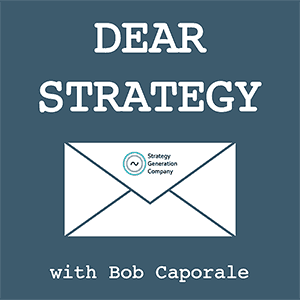Dear Strategy:
“I have a product that uniquely meets the needs of a large target market, but I can’t seem to reach them. What should I do?”
For regular followers of this blog (and podcast), you know that we’re just coming off a 5-part series that was 100% dedicated to understanding the target market for your product or business. (See Episode 81 to view the first of those five posts). The premise of that series, of course, was that you need to deeply understand the pain points and needs of your targeted customer base if you expect to have any chance of attracting those customers to your product or business. But as sound as that advice may be, it’s still only half the story – as will be evidenced by my answer to this week’s question.
So, let’s say you have a brand-new product ready to hit the market that solves problems in a way that no other product can. It’s affordable, it’s of high-quality, and it’s adored by each and every prospective customer you’ve tested it with. You’ve done all the homework that we talked about in the previous 5 posts, you know exactly who your target market is and what their needs are, and you’ve developed a product that should, for all intents and purposes, be a runaway hit.
Even with all that, this incredible new product isn’t going to generate one single dollar in revenue for you if nobody knows that it exists.
It may seem obvious that you need to get the word out about your products but, believe it or not, many companies often forget to factor this all-important step into their product development equations. In fact, it’s not uncommon, even for the largest of companies that I work with, to see relatively large product development budgets without one thin dime allocated for promotional expenses. Even when formal launches are considered, it is often assumed that any required promotional activities will be paid for out of the already established annual marketing budgets – only to discover later that those budgets had already been fully allocated to other projects. So, without any money to spend, many launches get relegated to nothing more than a thin brochure, a quick catalog page, and maybe a shout out or two on the company’s social media feed.
And as bad as all that may sound; for smaller companies, the problem can actually be much worse. Even without doing any direct product marketing at all, most larger companies are going to have some amount of natural reach simply based on the size of their built-in customer base. For example, if Apple releases a new product, chances are, most of us are going to hear about it, regardless of how much advertising Apple decides to do. But for smaller companies, this dynamic is virtually non-existent. And that equates to having to work extra hard to let people know that your product exists. Which also equates to having to spend way more money than most small business owners will probably be comfortable spending.
What this all boils down to is, no matter what size business you have, you need to build a certain amount of marketing dollars into your product development budgets. And then you’re going to have to budget for far more ongoing marketing dollars than you think you’ll need in order to keep your product at the front of your customers’ minds. Companies that have figured this out are usually the ones on top. And companies that haven’t, are usually the ones standing on the sidelines wondering why so many people keep buying their competitors’ “not quite as good” products.
” You’re going to have to budget far more ongoing marketing dollars than you think you’ll need in order to keep your product at the front of your customers’ minds.”
So, marketing isn’t always the first thing you think about, and it usually isn’t cheap. That much we know. But there’s one more warning flag that needs to be raised before you jump head first into this world of self-loving promotional bliss.
That is – it can be darned uncomfortable.
Product creators like to build things. They like to take ideas out of peoples’ heads and make those ideas into realities. But do you know what they don’t always like to do?
Market themselves.
Now, I’m no psychologist, and I am far from ever having done any kind of a formal study on what I’m about to surmise. But, in my experience, I can tell you that building things and marketing things are two very different skillsets. And I can also tell you that I’ve only met a relatively small number of people who can do both of those things really well. I mean really well. So, my last piece of advice with respect to this question would be to team up with someone who’s really good at marketing, and then consider that person an equal partner in the success of your product or business.
So, there you have it. If you want to reach your target audience, you’re going to have to:
- Consider marketing
- Budget for marketing
- Partner with someone who’s really good at marketing
Assuming you really do have a product that knocks it out of the park for your customers, the only thing left to do is let them know about it. And that’s just not something you should be trying to do alone; lest you end up forgetting to do it altogether.
Listen to the podcast episode
Dear Strategy: Episode 086

###
Are you interested in strategy workshops for your product, marketing, or business managers? If so, please be sure to visit Strategy Generation Company by clicking the link below:
 Bob Caporale is the founder of Strategy Generation Company, the author of Creative Strategy Generation and the host of the Dear Strategy podcast. You can learn more about his work by visiting bobcaporale.com.
Bob Caporale is the founder of Strategy Generation Company, the author of Creative Strategy Generation and the host of the Dear Strategy podcast. You can learn more about his work by visiting bobcaporale.com.






